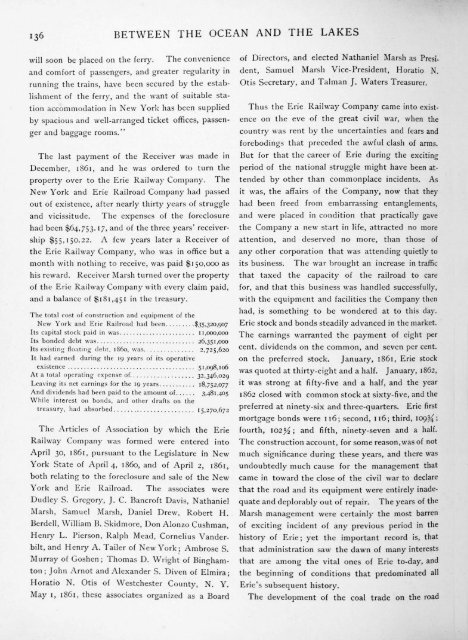Create successful ePaper yourself
Turn your PDF publications into a flip-book with our unique Google optimized e-Paper software.
136 BETWEEN THE OCEAN AND THE LAKES<br />
will soon be placed on the ferry.<br />
The convenience<br />
and comfort of passengers, and greater regularity in<br />
running the trains, have been secured by the establishment<br />
of the ferry, and the want of suitable station<br />
accommodation in New York has been supplied<br />
by spacious and well-arranged ticket offices, passenger<br />
and baggage rooms."<br />
The last payment of the Receiver was made in<br />
December, 1861, and he was ordered to turn the<br />
property over to the Erie Railway Company.<br />
The<br />
New York and Erie Railroad Company had passed<br />
out of existence, after nearly thirty years of struggle<br />
and vicissitude.<br />
The expenses of the foreclosure<br />
had been $64,753.17, and of the three years' receivership<br />
$55,150.22. A few years later a Receiver of<br />
the Erie Railway Company, who was in office but a<br />
month with nothing to receive, was paid $150,000 as<br />
his reward. Receiver Marsh turned over the property<br />
of the Erie Railway Company with every claim paid,<br />
and a balance of $181,451 in the treasury.<br />
The total cost of construction and equipment of the<br />
New York and Erie Railroad had been $35,320,907<br />
Its capital stock paid in was 11,000,000<br />
Its bonded debt was 26,351,000<br />
Its existing floating debt, i860, was 2,725,620<br />
It had earned during the 19 years of its operative<br />
existence 51,098,106<br />
At a total operating expense of. 32,346,029<br />
Leaving its net earnings for the 19 years 18,752,077<br />
And dividends had been paid to the amount of 3,481,405<br />
While interest on bonds, and other drafts on the<br />
treasury, had absorbed 15,270,672<br />
The Articles of Association by which the Erie<br />
Railway Company was formed were entered into<br />
April 30, 1861, pursuant to the Legislature in New<br />
York State of April 4, i860, and of April 2, 1861,<br />
both relating to the foreclosure and sale of the New<br />
York and Erie Railroad. The associates were<br />
Dudley S. Gregory, J. C. Bancroft Davis, Nathaniel<br />
Marsh, Samuel Marsh, Daniel Drew, Robert H.<br />
Berdell, William B. Skidmore, Don Alonzo Cushman,<br />
Henry L. Pierson, Ralph Mead, Cornelius Vanderbilt,<br />
and Henry A. Tailer of New York; Ambrose S.<br />
Murray of Goshen; Thomas D. Wright of Binghamton<br />
; John Arnot and Alexander S. Diven of Elmira;<br />
Horatio N. Otis of Westchester County, N. Y.<br />
May 1, 1861, these associates <strong>org</strong>anized as a Board<br />
of Directors, and elected Nathaniel Marsh as President,<br />
Samuel Marsh Vice-President, Horatio N.<br />
Otis Secretary, and Talman J. Waters Treasurer.<br />
Thus the Erie Railway Company came into existence<br />
on the eve of the great civil war, when the<br />
country was rent by the uncertainties and fears and<br />
forebodings that preceded the awful clash of arms.<br />
But for that the career of Erie during the exciting<br />
period of the national struggle might have been attended<br />
by other than commonplace incidents. As<br />
it was, the affairs of the Company, now that they<br />
had been freed from embarrassing entanglements,<br />
and were placed in condition that practically gave<br />
the Company a new start in life, attracted no more<br />
attention, and deserved no more, than those of<br />
any other corporation that was attending quietly to<br />
its business. The war brought an increase in traffic<br />
that taxed the capacity of the railroad to care<br />
for, and that this business was handled successfully,<br />
with the equipment and facilities the Company then<br />
had, is something to be wondered at to this day.<br />
Erie stock and bonds steadily advanced in the market.<br />
The earnings warranted the payment of eight per<br />
cent, dividends on the common, and seven per cent.<br />
on the preferred stock. January, 1861, Erie stock<br />
was quoted at thirty-eight and a half. January, 1862,<br />
it was strong at fifty-five and a half, and the year<br />
1862 closed with common stock at sixty-five, and the<br />
preferred at ninety-six and three-quarters. Erie first<br />
mortgage bonds were 116; second, 116; third, 109^;<br />
fourth, 102^ ; and fifth, ninety-seven and a half.<br />
The construction account, for some reason,was of not<br />
much significance during these years, and there was<br />
undoubtedly much cause for the management that<br />
came in toward the close of the civil war to declare<br />
that the road and its equipment were entirely inadequate<br />
and deplorably out of repair. The years of the<br />
Marsh management were certainly the most barren<br />
of exciting incident of any previous period in the<br />
history of Erie; yet the important record is, that<br />
that administration saw the dawn of many interests<br />
that are among the vital ones of Erie to-day, and<br />
the beginning of conditions that predominated all<br />
Erie's subsequent history.<br />
The development of the coal trade on the road
















